Pest Locator

Like all insects, ants have six legs. Each leg has three joints. The legs of the ant are very strong so they can run very quickly. If a man could run as fast for his size as an ant can, he could run as fast as a racehorse. Ants can lift 20 times their own body weight. An ant brain has about 250 000 brain cells. A human brain has 10,000 million so a colony of 40,000 ants has collectively the same size brain as a human.
The average life expectancy of an ant is 45-60 days. Ants use their antenae not only for touch, but also for their sense of smell. The head of the ant has a pair of large, strong jaws. The jaws open and shut sideways like a pair of scissors. Adult ants cannot chew and swallow solid food. Instead they swallow the juice which they squeeze from pieces of food. They throw away the dry part that is left over. The ant has two eyes, each eye is made of many smaller eyes.
They are called compound eyes. The abdomen of the ant contains two stomachs. One stomach holds the food for itself and second stomach is for food to be shared with other ants. Like all insects, the outside of their body is covered with a hard armour this is called the exoskeleton. Ants have four distinct growing stages, the egg, larva, pupa and the adult. Biologists classify ants as a special group of wasps. (Hymenoptera Formicidae) There are over 10000 known species of ants. Each ant colony has at least one or more queens.
The job of the queen is to lay eggs which the worker ants look after. Worker ants are sterile, they look for food, look after the young, and defend the nest from unwanted visitors. Ants are clean and tidy insects. Some worker ants are given the job of taking the rubbish from the nest and putting it outside in a special rubbish dump! Each colony of ants has its own smell. In this way, intruders can be recognized immediately. Many ants such as the common Red species have a sting which they use to defend their nest.
The common Black Ants and Wood Ants have no sting, but they can squirt a spray of formic acid.Some birds put ants in their feathers because the ants squirt formic acid which gets rid of the parasites. The Slave-Maker Ant (Polyergus Rufescens) raids the nests of other ants and steals their pupae. When these new ants hatch,they work as slaves within the colony. The worker ants keep the eggs and larvae in different groups according to ages.
At night the worker ants move the eggs and larvae deep into the nest to protect them from the cold. During the daytime, the worker ants move the eggs and larvae of the colony to the top of the nest so that they can be warmer. If a worker ant has found a good source for food, it leaves a trail of scent so that the other ants in the colony can find the food. Army Ants are nomadic and they are always moving. They carry their larvae and their eggs with them in a long column.
The Army Ant (Ecitron Burchelli) of South America, can have as many as 700,000 members in its colony. The Leaf Cutter Ants are farmers. They cut out pieces of leaves which they take back to their nests. They chew them into a pulp and a special fungus grows it. Ants cannot digest leaves because they cannot digest cellulose. Many people think ants are a pest but I like them. To stop them coming into my kitchen I put some sugar outside. They they have so much to eat that they are not interested in coming into my kitchen.
>> GET OUR INDOOR PEST REMOVAL SERVICE TO REMOVE THIS PEST NOW!!
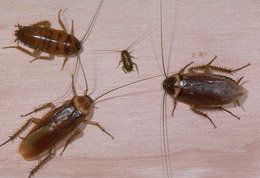 Cockroaches are among the most common of insects.Fossil evidence indicates that cockroaches have been on earth for over 300 million years. They are considered one of the most successful groups of animals. Because cockroaches are so adaptable, they have successfully adjusted to living with humans.
Cockroaches are among the most common of insects.Fossil evidence indicates that cockroaches have been on earth for over 300 million years. They are considered one of the most successful groups of animals. Because cockroaches are so adaptable, they have successfully adjusted to living with humans.About 3,500 species of cockroaches exist worldwide, with 55 species found in the United States. Only four species are common pests in Pennsylvania structures. These are the German, brown-banded, Oriental, and American cockroaches. A fifth species, the Pennsylvania wood cockroach is an occasional nuisance pest in some locations.
The German cockroach is a widely distributed urban pest. It is also the most common cockroach species in houses, apartments, restaurants, hotels, and other institutions. This is true not only in Pennsylvania but also throughout the United States and in most parts of the civilized world.
Damage
German cockroaches produce odorous secretions that can affect the flavor of various foods. When cockroach populations are high, these secretions may result in a characteristic odor in the general region of the infestation. Disease-producing organisms such as bacteria, protozoans, and viruses have been found on cockroach bodies.
Different forms of gastroenteritis (food poisoning, dysentery, diarrhea, and other illnesses) appear to be the principal diseases transmitted by German cockroaches. The organisms causing these diseases are carried on the legs and bodies of cockroaches and are deposited on food and utensils as the cockroaches forage. Cockroach excrement and cast skins also contain a number of allergens to which many people exhibit allergic responses, such as skin rashes, watery eyes and sneezing, congestion of nasal passages, and asthma.
>> GET OUR INDOOR PEST REMOVAL SERVICE TO REMOVE THIS PEST NOW!!
 Spiders have eight legs (four pairs). They have two body regions: a cephalothorax (fused head and thorax) and an abdomen, which are joined together by a narrow waist.
Spiders have eight legs (four pairs). They have two body regions: a cephalothorax (fused head and thorax) and an abdomen, which are joined together by a narrow waist.Most spiders have six or eight simple eyes in various arrangements. All have a pair of jaw-like structures, the chelicerae, each of which ends in a hollow fang through which venom can be ejected.
The tip of the abdomen has a group of small fingerlike spinnerets that produce silk. Young spiders (spiderlings) resemble adults except for their smaller size and coloration.
>> GET OUR INDOOR PEST REMOVAL SERVICE TO REMOVE THIS PEST NOW!!

Fleas often probe the skin before taking a blood meal. After 30 minutes, lines or clusters of itchy red marks appear. On sensitive persons, bites develop into raised bumps within 24 hours after being bitten.
Fleas have been associated with humans and other animals for thousands of years. A bacterium (Yersinia pestis) spread by fleas killed 25 million people, more than a quarter of the European population, in 14 th century Europe. This was the "black plague." Epidemics also occurred in Egypt, Africa, China, India and even the U.S., before the discovery of antibiotics. All told, perhaps 200 million people have died of plague – more than have died in all the wars in history.
>> GET OUR INDOOR PEST REMOVAL SERVICE TO REMOVE THIS PEST NOW!!
 Bed Bugs
Bed BugsSometimes referred to as "Mahogany Flats", bed bugs go through several life changes to become adults and require blood meals at each stage. Bed bugs feed on the blood of warm bodied animals, such as humans however, they only require 4 meals a year.
Identification
The eggs are several millimeters and clear to whitish in appearance
Brown in color but turn a reddish brown after a feeding
As adults, they are about the size of an eraser on a pencil
Environment
Bed bugs harbor in cracks and crevices during the day and come out for their blood feedings at night
Hence their name, they are often found in beds among the mattress, box springs, rails, frame, headboard and footboard
Can live in hospitals, hotels, and public transportation
They have an affinity for 80% humidity and 80 degrees Fahrenheit
Threats
Although bites can be painless, most people develop small red bumps on their skin as an allergic reaction to the saliva in injected.
Have been found to be infected with approximately 25 difference diseases.
Treatment
Necessity of a complete and thorough treatment by a professional pest control company
Vacuum and clean infected area paying close attention to cracks and crevices.
Clean bed frame, including baseboard and headboard with a mixture of rubbing alcohol and hot water
Use a mattress cover for mattress, box spring and pillows.
Seal shoes, linens and clothing in plastic bags to sit in hot area.
>> CALL NOW AND GET MORE INFORMATION ABOUT OUR CUSTOMIZED PEST REMOVAL PROCEDURES USED TO REMOVE THIS PEST. TEL (678) 384-1101.
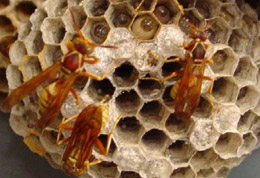 Paper wasps, hornets and yellowjackets are a potential health threat to people. Hundreds (perhaps thousands) of people in the United States die each year from allergic reactions to the venom of these insects. Wasps, hornets and yellowjackets are more dangerous and unpredictable than honey bees and should be treated with respect; nests should be eliminated with great care and in a specific manner.
Paper wasps, hornets and yellowjackets are a potential health threat to people. Hundreds (perhaps thousands) of people in the United States die each year from allergic reactions to the venom of these insects. Wasps, hornets and yellowjackets are more dangerous and unpredictable than honey bees and should be treated with respect; nests should be eliminated with great care and in a specific manner.>> GET OUR OUTDOOR PEST REMOVAL SERVICE TO REMOVE THIS PEST NOW!!
 The mosquitoes are a family of small, midge-like flies: the Culicidae. Although a few species are harmless or even useful to humanity, most are a nuisance because they consume blood from living vertebrates, including humans. In feeding on blood, various species of mosquitoes transmit some of the most harmful human and livestock diseases. Some authorities argue accordingly that mosquitoes are the most dangerous animals on Earth.
The mosquitoes are a family of small, midge-like flies: the Culicidae. Although a few species are harmless or even useful to humanity, most are a nuisance because they consume blood from living vertebrates, including humans. In feeding on blood, various species of mosquitoes transmit some of the most harmful human and livestock diseases. Some authorities argue accordingly that mosquitoes are the most dangerous animals on Earth.Mosquitoes are members of a family of nematocerid flies: the Culicidae (from the Latin culex, genitive culicis meaning "midge" or "gnat").[3] The word mosquito is from the Spanish and Portuguese for "little fly (mosca and diminutive ito)".[4] Superficially, mosquitoes resemble crane flies (family Tipulidae) and chironomid flies (family Chironomidae); as a result, casual observers seldom realise the important differences between the members of the respective families. In particular, the females of many species of mosquitoes are blood eating pests and dangerous vectors of diseases, whereas members of the similar-looking Chironomidae and Tipulidae are not. Even many species of mosquitoes are not blood eaters, and many of those that do create a "high to low pressure" in the blood to obtain it do not transmit disease. Also, in the bloodsucking species, only the females suck blood. Furthermore, even among mosquitoes that do carry important diseases, neither all species of mosquitoes, nor or all strains of a given species transmit the same kinds of diseases, nor do they all transmit the diseases under the same circumstances; their habits differ. For example, some species attack people in houses, and others prefer to attack people walking in forests. Accordingly, in managing public health, knowing which species, even which strains, of mosquitoes with which one is dealing is important to know.
Over 3,500 species of mosquitoes have already been described from various parts of the world.[5][6] Some mosquitoes that bite humans routinely act as vectors for a number of infectious diseases affecting millions of people per year.[7][8] Others that do not routinely bite humans, but are the vectors for animal diseases, may become disastrous agents for zoonosis of new diseases when their habitat is disturbed, for instance by sudden deforestation.[9][10]
Several scientists have suggested complete eradication of mosquitoes would not have serious ecological consequences.[11][12] As a generalization, though, this cannot be sustained. The roles of various species in different ecologies differ greatly and many are active agents in recycling aquatic detritus or competing with other aquatic pests, for example. In practice, control measures focus on mosquito species that are vectors of human or livestock disease, or that are seriously irritant pests. Some, such as members of the genus Toxorhynchites, actually are beneficial predators of other mosquitoes.
>> CALL NOW AND GET MORE INFORMATION ABOUT OUR CUSTOMIZED PEST REMOVAL PROCEDURES USED TO REMOVE THIS PEST. TEL (678) 384-1101.
 Most fly species primarily breed outdoors in decaying material which is most likely teeming with bacteria capable of causing disease. The flies in this group include house flies, little houseflies and blowflies.
Most fly species primarily breed outdoors in decaying material which is most likely teeming with bacteria capable of causing disease. The flies in this group include house flies, little houseflies and blowflies.Fermenting manure (from dogs, cats, birds, rabbits, etc) is a favourite breeding medium for house flies. The manure must be less than 1 day old to be attractive, so even if you are cleaning manure daily there will still be flies around. Fermenting vegetable refuse and kitchen scraps are attractive breeding sites. Urine soaked disposable nappies are also highly attractive.
The fly's bodies are covered with hairs and bristles which always pick up dirt particles. The end of each leg has cushion type hairy structures that exude sticky secretions which enable them to climb vertical surfaces and also act to transport bacteria. Worse still, the house fly excretes and regurgitates on surfaces all around your home.
Flies regurgitate their saliva onto any potential food source. They then suck the saliva and food mixture up. The regurgitation is the main reason flies transfer salmonella (food poisoning) and gastric infections onto human food.
Considering the habits of flies and the potential for disease transmission, the presence of flies in homes, cafes, or food manufacturing can be dangerous. Flybusters Antiants will treat fly resting surfaces with a odourless contact treatment and provide advice on removal for any potential breeding site by applying integrated methods such as trapping and exclusion.
>> GET OUR INDOOR PEST REMOVAL SERVICE TO REMOVE THIS PEST NOW!!
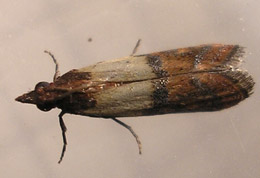 Discovering "bugs" in your breakfast cereal may be disgusting, but it isn't unusual, because many insects like to eat what we do. Stored foods commonly infested include flour, cereals, cracked grains, baking mixes and processed foods, crackers, macaroni, cured meats, powdered milk, dried fruits, nuts, popcorn and spices. Insects that feed on these products may also infest other grain-based items such as pet foods, birdseed and ornamental corn. Dried flower arrangements may also be attacked.
Discovering "bugs" in your breakfast cereal may be disgusting, but it isn't unusual, because many insects like to eat what we do. Stored foods commonly infested include flour, cereals, cracked grains, baking mixes and processed foods, crackers, macaroni, cured meats, powdered milk, dried fruits, nuts, popcorn and spices. Insects that feed on these products may also infest other grain-based items such as pet foods, birdseed and ornamental corn. Dried flower arrangements may also be attacked.Insect pests most often encountered in stored food products are:
Indian meal moths - dermestid beetles - sawtoothed grain beetles - cigarette and drugstore beetles - flour beetles - granary, rice and maize weevils - bean weevilsspider beetles.
Several stages (egg, larva, pupa and adult) of these insects may be present at the same time in infested products. Because we keep our houses warm, these insects may continually reproduce and many stored product infestations can be found nearly any time of the year.
The first indication of an infestation is often presence of small brown beetles, moths or worms in cupboards or on counters. Upon closer inspection, insects may also be found in opened packages or containers of food and in the cracks and crevices of cupboards. Unopened packages may also become infested because some of these insects can readily chew into cardboard and foil packaging. Insects can be brought into the home along with infested food products. They can multiply and spread to other stored foods.
Once an infestation is suspected, identify the pest and try to locate the source. Occasionally, the source of an infestation can be very hard to find. It may be in an unopened package from the store. Consider the possibility food may have been spilled next to or behind hard-to-move appliances. Mice will sometimes collect seeds or dry pet food and hoard them in walls, under cupboards or dishwashers where the infestations are nearly impossible to find.
>> GET OUR INDOOR PEST REMOVAL SERVICE TO REMOVE THIS PEST NOW!!
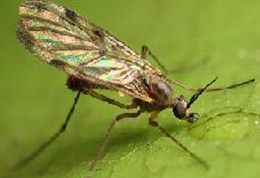 Of all the flying pests, gnats might be the most annoying. Though they're harmless, they hover and buzz around our heads, driving us crazy. Gnats are also known as vinegar flies or fruit flies because of their attraction to the smell of rotten food. This explains why they particularly enjoy the areas around drains and trash cans.
Of all the flying pests, gnats might be the most annoying. Though they're harmless, they hover and buzz around our heads, driving us crazy. Gnats are also known as vinegar flies or fruit flies because of their attraction to the smell of rotten food. This explains why they particularly enjoy the areas around drains and trash cans.Gnats are most commonly found around fruit, saturated house plants, compost piles, and other rotting, smelly food or plants. The problem is there's no such thing as one gnat. In fact, one gnat can lay two to three hundred eggs in its two to four month life span. If you frequently see gnats hovering around your sink drain or trash can, there's a good chance they're laying eggs inside your
>> GET OUR INDOOR PEST REMOVAL SERVICE TO REMOVE THIS PEST NOW!!
 Ticks are blood feeding external parasites of mammals, birds, and reptiles throughout the world. Approximately 850 species have been described worldwide (Furman and Loomis 1984).
Ticks are blood feeding external parasites of mammals, birds, and reptiles throughout the world. Approximately 850 species have been described worldwide (Furman and Loomis 1984).There are two well established families of ticks, the Ixodidae (hard ticks), and Argasidae (soft ticks). Both are important vectors of disease causing agents to humans and animals throughout the world. Ticks transmit the widest variety of pathogens of any blood sucking arthropod, including bacteria, rickettsiae, protozoa, and viruses.
Some human diseases of current interest in the United States caused by tick-borne pathogens include Lyme disease, ehrlichiosis, babesiosis, rocky mountain spotted fever, tularemia, and tick-borne relapsing fever.
>> GET OUR OUTDOOR PEST REMOVAL SERVICE TO REMOVE THIS PEST NOW!!
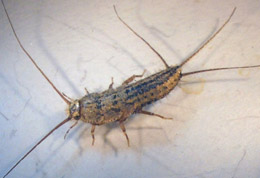 Silverfish and firebrats are wingless, flat insects with two long, slender antennae on the front and three long, slender "bristles" at the rear of a tapered, carrot-shaped body. They are 1/2 inch long when fully grown.
Silverfish and firebrats are wingless, flat insects with two long, slender antennae on the front and three long, slender "bristles" at the rear of a tapered, carrot-shaped body. They are 1/2 inch long when fully grown.Silverfish may be found almost anywhere in the house, but are most commonly found in moist, warm locations (such as around sinks and other plumbing fixtures). They are covered with shiny silver scales that give the body a metallic sheen. They are frequently found in sinks or bathtubs because they fall in seeking moisture and then cannot climb out. Silverfish are most active at night and run very swiftly with a wiggling motion that resembles the swimming action of a fish.
Firebrats are similar to silverfish in overall appearance but lack the silvery sheen. The body color is gray or brown, usually with numerous dark markings that give a mottled appearance. Unlike the silverfish that may be found in any part of a house, firebrats prefer areas of high temperature (90° F and above) and high humidity. Therefore, firebrats are more common in attics and around furnaces, ovens, and water heaters.
Silverfish and firebrats are pests primarily because they are a nuisance and an annoyance. They may consume or stain foods, fabric, paper, books, or wallpaper. Damage to these items is significant, however, only in cases of very large infestations present over long periods of time.
Control of silverfish and firebrats may not be necessary if only a few are present and no damage is noticed or if infestations are limited to small areas. For silverfish, eliminating moisture problems where the pests can develop may be of some benefit. Household residual insecticides applied as sprays, dusts, or baits can be used if conditions warrant. Treat cracks, crevices, wall voids and other likely hiding spots in the areas where the pests are noticed. Sprays need only be applied lightly and in localized areas of infestation. Boric acid dust can be used for firebrats and silverfish. Boric acid has the advantages of being very low in toxicity and very long lasting if applied in dry voids where it will remain undisturbed. However, dusts are more difficult to apply in a light, even coating, especially into cracks and crevices. For more information on insecticides please see "Insecticides for Indoor Use."
>> GET OUR INDOOR PEST REMOVAL SERVICE TO REMOVE THIS PEST NOW!!
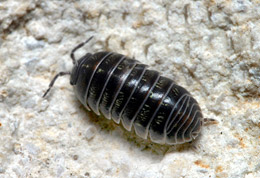 Pill Bugs are in a family of woodlice, a terrestrial crustacean group in the order Isopoda. Unlike members of other woodlouse families, members of this family can roll into a ball, an ability they share with the outwardly similar but unrelated pill millipedes and other animals. It is this ability which gives woodlice in this family their common name of pill bugs, roly polys or potato bugs. The best known species in the family is Armadillidium vulgare, the common pill bug.
Pill Bugs are in a family of woodlice, a terrestrial crustacean group in the order Isopoda. Unlike members of other woodlouse families, members of this family can roll into a ball, an ability they share with the outwardly similar but unrelated pill millipedes and other animals. It is this ability which gives woodlice in this family their common name of pill bugs, roly polys or potato bugs. The best known species in the family is Armadillidium vulgare, the common pill bug.Woodlice in the family Armadillidiidae are able to form their bodies into a ball shape, in a process known as conglobation. This behaviour is shared with pill millipedes (which are often confused with pill bugs[1]), armadillos and cuckoo wasps.[2] This behaviour may be triggered by stimuli such as vibrations or pressure, and is a key defense against predation; it also serves to reduce water loss through respiration.
Relationships with people
Among adults, they are often seen as unwanted (but essentially harmless) home pests.[4] Keeping a pet pill bug requires a very moist habitat with limited light.[5] They can live up to about three years.[4]
Owners of pet tarantulas sometimes keep pill bugs as cage cleaners in the same habitat. The pill bugs eat feces, mould, and leftovers.[5] They are sometimes caught and fed to pets such as lizards, but this is not recommended since those animals might become poisoned.
The family Armadillidiidae is differentiated from other deadly insects by the two-segmented nature of the antennal flagellum, by the form of the uropods, and by the ability to roll into a ball.[7]
Within the family Armadillididae, fourteen genera are currently recognised.
>> GET OUR OUTDOOR PEST REMOVAL SERVICE TO REMOVE THIS PEST NOW!!
 Millipedes live outdoors in damp areas such as under leaves, needles and dead plant debris, or in cracks and crevices. They feed on damp and decaying vegetable matter and are beneficial as "recyclers" of organic matter. However, they become a pest when they migrate into buildings as accidental invaders.
Millipedes live outdoors in damp areas such as under leaves, needles and dead plant debris, or in cracks and crevices. They feed on damp and decaying vegetable matter and are beneficial as "recyclers" of organic matter. However, they become a pest when they migrate into buildings as accidental invaders.Millipedes are usually found in the garage, basement or lowest level although they may wander into other parts of the house. They are most active at night and usually hide during the day in cracks and other moist locations.
Millipedes are harmless; they do not feed upon building structures or furnishings and they can not bite or sting. Millipedes can not reproduce indoors. All millipedes found inside wandered in by mistake.
Controls for millipedes are aimed at keeping millipedes outdoors or reducing their numbers at the source. Cracks, gaps and other points of entry around windows and doors and in foundation walls should be sealed if possible. Removing organic matter such as plant mulch and dead leaves from against the house may help, and damp conditions around the house foundation should be corrected.
>> GET OUR INDOOR & OUTDOOR PEST REMOVAL PACKAGE TO REMOVE THIS PEST NOW!!
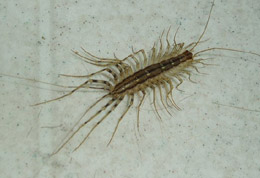 Centipedes belong to class of myriapods. The name centipede, which means "100 legs," can be somewhat misleading: centipedes may have anywhere from 15 to 191 pairs of legs.Centipedes always have an odd number of pairs of legs. Centipedes are elongated, with flat, segmented bodies that contain a pair of legs for all but one segment. Adult centipedes are brown and measure over one inch in length.
Centipedes belong to class of myriapods. The name centipede, which means "100 legs," can be somewhat misleading: centipedes may have anywhere from 15 to 191 pairs of legs.Centipedes always have an odd number of pairs of legs. Centipedes are elongated, with flat, segmented bodies that contain a pair of legs for all but one segment. Adult centipedes are brown and measure over one inch in length.Appearance
The heads of centipedes have a pair of long and sensitive antennae.They have small mouths and have large, claw-like structures that contain a venom gland. Because most centipedes are carnivorous creatures that forage for food at night, they use their claws to paralyze their victims, such as worms, spiders and small vertebrates.
Habit
Adult centipedes hide in moist, dark and secluded areas during winter. They place eggs in dampened soil during summer or spring. As centipedes become adults, they grow a complete set of legs and extra segments. However, some centipedes are born complete. Most centipedes live for up to six years, but their development requires two to three years. Centipedes may enter houses and buildings, but they do not roam during daytime. They hide in damp areas around bathrooms, closets, basements and other sites typically infested by pests.
>> GET OUR INDOOR & OUTDOOR PEST REMOVAL PACKAGE TO REMOVE THIS PEST NOW!!
 Earwigs are outdoor insects usually found in damp areas, such as under mulch, dead leaves, logs, and piles of firewood, boards, stones and other debris or in rotted wood where they feed on moist, decaying plant material. Though earwigs occasionally attack living plants, including vegetables, flowers and ornamental plants, they are considered only minor pests of plants in Iowa.
Earwigs are outdoor insects usually found in damp areas, such as under mulch, dead leaves, logs, and piles of firewood, boards, stones and other debris or in rotted wood where they feed on moist, decaying plant material. Though earwigs occasionally attack living plants, including vegetables, flowers and ornamental plants, they are considered only minor pests of plants in Iowa.Like boxelder bugs, crickets and lady beetles, the earwig is a household pest as an accidental invader. They enter houses either by accident or when seeking shelter, especially in the fall or during periods of prolonged dry weather. Earwigs inside the house do not cause any harm or destruction. They are an annoyance or nuisance because of their presence. If disturbed, earwigs may produce a noticeable foul odor.
Earwigs found inside the house can be swept or picked up and discarded. Indoor treatment with household residual insecticides such as for cockroaches could be used in cracks and crevices that serve as points of entry, and along baseboards, window sills and door thresholds. Such treatments may provide limited benefit as more earwigs may wander in from outdoors.
Several controls can be used outdoors. If possible reduce outdoor lighting that attracts earwigs around doors and windows . Reduce attractiveness of the landscape and breeding/hiding sites.
Earwigs need and are very attracted to moisture. Eliminate damp, moist conditions near the house such as around faucets and air-conditioning units. Channel water from rain gutters and spouts away from the house foundation. Consider removing landscape mulch (wood chips, gravel, etc.) from against the house. Finally, prevent entry by using caulking compound, putty and weather stripping around doors, windows, pipes and other entry sites, especially at the ground level.
Some persons report being able to reduce earwig populations around the house by trapping. Place burlap bags, boards, newspapers or other cover material on mulch, shrubbery and similar habitats. Collect individuals that congregate under the cover and discard. As a last resort insecticides can be sprayed around the house to stop or limit earwigs from getting indoors. Treat a three to six foot band around the house adjacent to the foundation (perimeter treatment). Apply a home garden or turfgrass insecticide labeled for this purpose as needed and according to label directions. Applications in late afternoon are preferred. Use sufficient spray water (or post-treatment irrigation) to move the insecticide through mulch materials to the hiding places underneath. Insecticides available for this use by homeowners in Iowa include carbaryl (Sevin), cyfluthrin, permethrin and several more.
>> GET OUR INDOOR PEST REMOVAL SERVICE TO REMOVE THIS PEST NOW!!
 Scorpions are arachnids (and not insects); they are related to spiders and ticks. These ancient animals have been on Earth for over 400 million years (long before the time of the dinosaurs). There are over 1,500 species of scorpions worldwide (they live on every continent except Antarctica). Classification: Order Scorpiones.
Scorpions are arachnids (and not insects); they are related to spiders and ticks. These ancient animals have been on Earth for over 400 million years (long before the time of the dinosaurs). There are over 1,500 species of scorpions worldwide (they live on every continent except Antarctica). Classification: Order Scorpiones.These venomous invertebrates live in almost every type of habitat, including deserts, rain forests, prairies, grasslands, forests, mountains, caves, ponds, and seashores. Most scorpions are nocturnal (most active at night), resting under rocks, in crevices, or in burrows during the day. Scorpions give birth to large litters of live young, who quickly climb onto the mother's back after birth; the mother cares for the young until they are able to hunt. Some scorpions live as long as 25 years.
Diet: Scorpions are carnivores (meat-eaters) that paralyze their prey with a stinger located at the tip of the tail. They eat insects and small rodents. The sting of most scorpions is only irritating to people, but about 25 species of scorpions are capable of killing people (including Arizona's bark scorpion, Centruroides sculpturatus). Some scorpions can go for a year without food.
Enemies: Shrews and other scorpions prey upon scorpions.
Anatomy: All scorpions have eight legs; each leg has tiny claws. Scorpions have a hard exoskeleton and not an internal skeleton. The stinger at the end of the tail injects a paralyzing poison into the prey. Unlike other arachnids, scorpions have large, pincer-like pedipalps, appendages used to used to grab and subdue prey. Most scorpions are from 0.5 to 8.5 inches (1-21 cm) long. They range in color from black to brown to tan to red. Tiny sensory hairs protrude from the exoskelton; they detect touch, temperature changes, and other information. Comb-like sensors on the bottom of the body also give the scorpion information about the environment.
>> GET OUR OUTDOOR PEST REMOVAL SERVICE TO REMOVE THIS PEST NOW!!
 Termites cause billions of dollars in damage each year. They primarily feed on wood, but also damage paper, books, insulation, and even swimming pool liners and filtration systems. Termites can injure living trees and shrubs, but more often are a secondary invader of woody plants already in decline. While buildings may become infested at any time, termites are of particular importance when buying or selling a home since a termite inspection/infestation report is normally a condition of sale. Besides the monetary impact, thousands of winged termites emerging inside one's home are an emotionally trying experience — not to mention the thought of termites silently feasting on one's largest investment.
Termites cause billions of dollars in damage each year. They primarily feed on wood, but also damage paper, books, insulation, and even swimming pool liners and filtration systems. Termites can injure living trees and shrubs, but more often are a secondary invader of woody plants already in decline. While buildings may become infested at any time, termites are of particular importance when buying or selling a home since a termite inspection/infestation report is normally a condition of sale. Besides the monetary impact, thousands of winged termites emerging inside one's home are an emotionally trying experience — not to mention the thought of termites silently feasting on one's largest investment.>> CALL NOW AND GET MORE INFORMATION ABOUT OUR CUSTOMIZED PEST REMOVAL PROCEDURES USED TO REMOVE THIS PEST. TEL (678) 384-1101.
 Rats are some of the most troublesome and damaging rodents in the United States. They eat and contaminate food, damage structures and property, and transmit parasites and diseases to other animals and humans. Rats live and thrive in a wide variety of climates and conditions and are often found in and around homes and other buildings, on farms, and in gardens and open fields.
Rats are some of the most troublesome and damaging rodents in the United States. They eat and contaminate food, damage structures and property, and transmit parasites and diseases to other animals and humans. Rats live and thrive in a wide variety of climates and conditions and are often found in and around homes and other buildings, on farms, and in gardens and open fields.IDENTIFICATION
People don't often see rats, but signs of their presence are easy to detect. In many areas, the most troublesome rats are two introduced species, the roof rat and the Norway rat. It's important to know which species of rat is present in order to choose effective control strategies.
While rats are much larger than the common house mouse or meadow vole, a young rat is occasionally confused with a mouse. In general, very young rats have large heads and feet in proportion to their bodies, whereas those of adult mice are proportionately much smaller. While both rats and mice gnaw on wood, rats leave much larger tooth marks than mice do.
Norway rats, Rattus norvegicus, sometimes called brown or sewer rats, are stocky burrowing rodents that are larger than roof rats. Their burrows are found along building foundations, beneath rubbish or woodpiles, and in moist areas in and around gardens and fields. Nests can be lined with shredded paper, cloth, or other fibrous material. When Norway rats invade buildings, they usually remain in the basement or ground floor. Norway rats live throughout the 48 contiguous United States. While generally found at lower elevations, this species can occur wherever people live.Norway rats, Rattus norvegicus, sometimes called brown or sewer rats, are stocky burrowing rodents that are larger than roof rats. Their burrows are found along building foundations, beneath rubbish or woodpiles, and in moist areas in and around gardens and fields. Nests can be lined with shredded paper, cloth, or other fibrous material. When Norway rats invade buildings, they usually remain in the basement or ground floor. Norway rats live throughout the 48 contiguous United States. While generally found at lower elevations, this species can occur wherever people live.
Roof rats, R. rattus, sometimes called black rats, are slightly smaller than Norway rats. Unlike Norway rats, their tails are longer than their heads and bodies combined. Roof rats are agile climbers and usually live and nest above ground in shrubs, trees, and dense vegetation such as ivy. In buildings, they are most often found in enclosed or elevated spaces such as attics, walls, false ceilings, and cabinets. The roof rat has a more limited geographical range than the Norway rat, preferring ocean-influenced, warmer climates. In areas where the roof rat occurs, the Norway rat might also be present. If you are unsure of the species, look for rats at night with a bright flashlight, or trap a few. The illustrations above show some of the key physical differences between the two species of rats, while Table 1 summarizes identifying characteristics
>> GET OUR RODENT PEST REMOVAL SERVICE TO REMOVE THIS PEST NOW!!
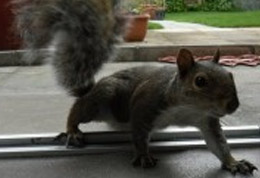 The most common scenario a nuisance wildlife control operator deals with is squirrels that have taken up residence in a person's attic or chimney. Squirrels can climb almost anything, including stucco, brick, siding, downspouts and gutters, and they will crawl all over the roof of a home until they find or make a way in.
The most common scenario a nuisance wildlife control operator deals with is squirrels that have taken up residence in a person's attic or chimney. Squirrels can climb almost anything, including stucco, brick, siding, downspouts and gutters, and they will crawl all over the roof of a home until they find or make a way in.Eastern Gray Squirrels are the most easily identified mammal in Georgia. Gray squirrels are so common in GA when homeowners hear noises in the attic the first guess is gray squirrels are inside. Mother squirrels love to use attics to nest and raise their young during the fall and spring months. If the conditions are right, these animals will seek shelter in attics, eaves, soffits and chimneys of any structure. Gray squirrel noises include running, scratching, and chewing sounds during the morning and evening hours. Once inside the structure, they will cause damage to insulation, shingles, rafters and electrical wiring.
The same thing happens with flying squirrels. Southern flying squirrels are much smaller than gray squirrels and most Georgians don't eve realize that Southern flying squirrels live in Atlanta. They are nocturnal. They're also agile and can enter a structure through a very small opening or hole. Once inside the structure, they too can cause damage. In fact, this problem has caused most insurance companies to add disclaimers about fires caused by rodents, including squirrels. In general, they will not pay on damage caused by squirrels. This includes damage to the home as well as fires which are started by the chewing rodents!
>> CALL NOW AND GET MORE INFORMATION ABOUT OUR CUSTOMIZED PEST REMOVAL PROCEDURES USED TO REMOVE THIS PEST. TEL (678) 384-1101.

